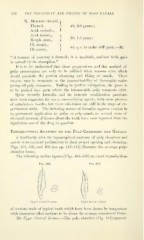Page 448 - My FlipBook
P. 448
;
446 THE TREATMENT AND FILLING OF ROOT CANALS.
I^. Mercuric chlorid, ^
Thymol, V da. 2.0 grams
Acid, carbolic, j
Acid, tannic,
\ l-'5 gram
T\T 1 I «''• ^ ;
Morph. mur., '
J
Ol. menth., I , .«>
^, . > aa. q.s. to make stin paste.—M.
Ol. cassise, ^ '
j
"A tannate of mercury is formed; it is insoluble, and but little pain
is caused by its absorption."
It is to be understood that these preparations and this method of
pulp preservation are only to be utilized when reasons exist which
would preclude the perfect cleansing and filling of canals. These
reasons may be economic or the impracticability of thoroughly extir-
pating all pulp remnants. Failing in perfect extirpation, the paste is
to be packed into parts where the irremovable pulp remnants exist.
Quite recently formalin and its isomeric modification paraform
have been suggested for use as mummifying agents, with some promise
of satisfactory results, but these substances are still in the stage of ex-
perimental study. The irritating nature of formalin suggests caution in
its permanent application to pulps or pulp canals, as several cases of
chemical necrosis of tissues about the teeth have been reported from the
injudicious use of the drug in question.
Topographical Anatomy of the Pulp Chambers and Canals.
A familiarity with the topographical anatomy of pulp chambers and
canals is an essential preliminary to their proper opening and cleansing.
Figs. 401, 402, and 403 (see pp. 443-445) illustrate the average pulp-
chamber forms.
The following outline figures (Figs. 404-439) are exact reproductions
Fig. 404. Fig. 405.
s
Tpper central incisor. Upper lateral incisor.
of sections made of typical teeth which have been shown by comparison
with numerous other sections to be about the average anatomical forms.
The Ujiper Central Incisor.—The pulp chamber (Fig. 404) approxi-
446 THE TREATMENT AND FILLING OF ROOT CANALS.
I^. Mercuric chlorid, ^
Thymol, V da. 2.0 grams
Acid, carbolic, j
Acid, tannic,
\ l-'5 gram
T\T 1 I «''• ^ ;
Morph. mur., '
J
Ol. menth., I , .«>
^, . > aa. q.s. to make stin paste.—M.
Ol. cassise, ^ '
j
"A tannate of mercury is formed; it is insoluble, and but little pain
is caused by its absorption."
It is to be understood that these preparations and this method of
pulp preservation are only to be utilized when reasons exist which
would preclude the perfect cleansing and filling of canals. These
reasons may be economic or the impracticability of thoroughly extir-
pating all pulp remnants. Failing in perfect extirpation, the paste is
to be packed into parts where the irremovable pulp remnants exist.
Quite recently formalin and its isomeric modification paraform
have been suggested for use as mummifying agents, with some promise
of satisfactory results, but these substances are still in the stage of ex-
perimental study. The irritating nature of formalin suggests caution in
its permanent application to pulps or pulp canals, as several cases of
chemical necrosis of tissues about the teeth have been reported from the
injudicious use of the drug in question.
Topographical Anatomy of the Pulp Chambers and Canals.
A familiarity with the topographical anatomy of pulp chambers and
canals is an essential preliminary to their proper opening and cleansing.
Figs. 401, 402, and 403 (see pp. 443-445) illustrate the average pulp-
chamber forms.
The following outline figures (Figs. 404-439) are exact reproductions
Fig. 404. Fig. 405.
s
Tpper central incisor. Upper lateral incisor.
of sections made of typical teeth which have been shown by comparison
with numerous other sections to be about the average anatomical forms.
The Ujiper Central Incisor.—The pulp chamber (Fig. 404) approxi-


